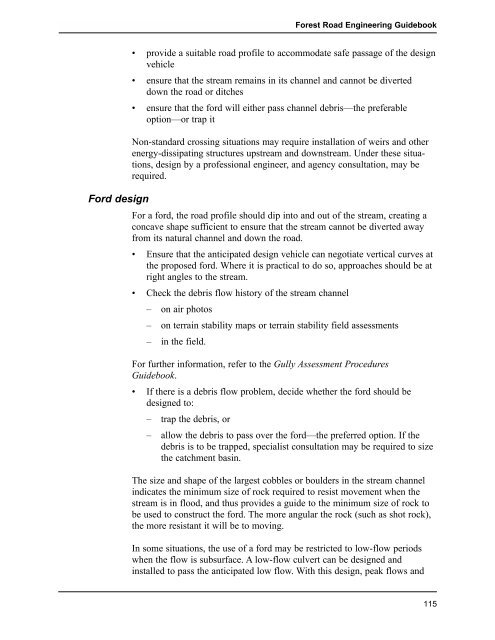Forest Road Engineering Guidebook - Ministry of Forests
Forest Road Engineering Guidebook - Ministry of Forests
Forest Road Engineering Guidebook - Ministry of Forests
Create successful ePaper yourself
Turn your PDF publications into a flip-book with our unique Google optimized e-Paper software.
Ford design<br />
<strong>Forest</strong> <strong>Road</strong> <strong>Engineering</strong> <strong>Guidebook</strong><br />
• provide a suitable road pr<strong>of</strong>ile to accommodate safe passage <strong>of</strong> the design<br />
vehicle<br />
• ensure that the stream remains in its channel and cannot be diverted<br />
down the road or ditches<br />
• ensure that the ford will either pass channel debris—the preferable<br />
option—or trap it<br />
Non-standard crossing situations may require installation <strong>of</strong> weirs and other<br />
energy-dissipating structures upstream and downstream. Under these situations,<br />
design by a pr<strong>of</strong>essional engineer, and agency consultation, may be<br />
required.<br />
For a ford, the road pr<strong>of</strong>ile should dip into and out <strong>of</strong> the stream, creating a<br />
concave shape sufficient to ensure that the stream cannot be diverted away<br />
from its natural channel and down the road.<br />
• Ensure that the anticipated design vehicle can negotiate vertical curves at<br />
the proposed ford. Where it is practical to do so, approaches should be at<br />
right angles to the stream.<br />
• Check the debris flow history <strong>of</strong> the stream channel<br />
– on air photos<br />
– on terrain stability maps or terrain stability field assessments<br />
– in the field.<br />
For further information, refer to the Gully Assessment Procedures<br />
<strong>Guidebook</strong>.<br />
• If there is a debris flow problem, decide whether the ford should be<br />
designed to:<br />
– trap the debris, or<br />
– allow the debris to pass over the ford—the preferred option. If the<br />
debris is to be trapped, specialist consultation may be required to size<br />
the catchment basin.<br />
The size and shape <strong>of</strong> the largest cobbles or boulders in the stream channel<br />
indicates the minimum size <strong>of</strong> rock required to resist movement when the<br />
stream is in flood, and thus provides a guide to the minimum size <strong>of</strong> rock to<br />
be used to construct the ford. The more angular the rock (such as shot rock),<br />
the more resistant it will be to moving.<br />
In some situations, the use <strong>of</strong> a ford may be restricted to low-flow periods<br />
when the flow is subsurface. A low-flow culvert can be designed and<br />
installed to pass the anticipated low flow. With this design, peak flows and<br />
115

















